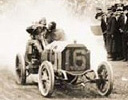Keeping It Off the Wall
by Ed Donath
Rules are meant to be…
2/10/04
Athens, NY—Now that we’re finally gearing up for the historic beginning of a new Champ Car racing season, many peoples’ questions have turned from if and when to why and how. Anarchists and law-and-order types alike have their ideas of how the rulebook should be better written. This renegade scribe is no exception:
For years I’ve said that STANDING STARTS will never be a guarantee against multi-car first-lap crashes; the main reason cited by proponents of Euro-style gridding for the necessity of its institution in the CWS. Well, my opinion hasn’t changed since the last piece I devoted to this subject back in August 2002 on the heels of a spate of first-lap schlimazels that had the anti-pace car crowd all cranked up. Why?
Despite its standing-start format, F1 has red-flagged and restarted more races than CART in the last decade. Only one of the two Champ Car races red-flagged before the completion of a single full lap during that 10-year timeframe occurred on a street or road circuit (’95 Molson Indy Vancouver). Thankfully, no one is arguing to discontinue flying starts at oval races—yet. Eliminating pace car starts would also eliminate one of the fuzzy distinctions between CART and Formula One. “First Turn Bottleneck Crash Syndrome” will never be eliminated by going to standing starts because the same number of cars will always reach the same dangerous point of the circuit at the same time—and always at the highest rate of speed possible—regardless of how the race is started.
Tire temperature is actually Champ Car racing’s biggest speed/handling inhibitor and first lap crash culprit. TIRE WARMING is what the series truly needs—both before its starts and in the pits—especially if mandatory pit stops are to continue.
SINGLE-CAR QUALIFYING, on the other hand, is an F1 concept that, in addition to bringing new excitement to the series, would also enhance safety while eliminating often-frustrating inconsistencies that drive both participants and fans crazy. If we are fortunate enough to get a TV package that includes qualifying, those who tune in would be riveted to their screens for each and every lap as drivers attempt to beat the clock—not the traffic.
Qualifying, after all, is about setting the field from the quickest driver back to the slowest. So why should one driver’s luck in selecting the optimum moment to run his hot laps during any given session take precedence over another driver’s misfortune in that same process?
And what of those drivers who try to seize an unfair, un-sportsmanlike advantage by intentionally making it difficult for fellow drivers to qualify?
The pole sitter should always be the driver who demonstrates the ability to conquer the challenges of the present circuit. Raw clocked speed should be the single qualifying criterion for that points-paying honor.
MANDATORY PIT STOPS are an abomination!
Regardless of whether Champ Cars continue to run with equally prepared engines, individual drivers will always have their own rhythms and fuel-consumption profiles. Following drivers’ ability to execute team orders embodies another of the most interesting concepts of modern motorsports.
With Champ Car teams possessing some of the savvy-est strategists on earth, stifling the creativity of this combined brain trust is tantamount to cutting a huge slab of the fan-interest pie out of the racing equation.
PUSH-TO-PASS is a trendy buzzword describing technology that is already a part of Champ Car racing. High-tech steering wheels have long included a button that, when pressed [very simply explained] immediately shifts fuel mixture to the “full rich” mode during the few seconds it takes for a driver to overtake another.
OWRS has indicated that, as a way of enhancing fan interest by encouraging on-track passing, it will institute some sort of updated push-to-pass technology. Anything from more sophisticated fuel mixture modulation to temporary turbo hyper-boost to perhaps even nitrous oxide injection is a possibility.
I have frequently ranted during the past few years that our beloved speed sport desperately needs more passing for position—especially to create and hold TV viewers’ interest. Therefore, as long as P2P can be perfected to work flawlessly and uniformly, it gets a big thumbs-up from me.
Finally, whatever rules package is ultimately adopted, the Chief Steward and his staff must be completely prepared to enforce each rule intelligently and with equanimity. The last thing we need is to leave exciting new pro-active concepts to wishy-washy officials to interpret and administer.
Rules; they are meant to be discussed and changed when necessary. Not broken.
Copyright © 2004 by Ed Donath and Deep Throttle. All Rights Reserved.
Ed Donath Archive
| 



